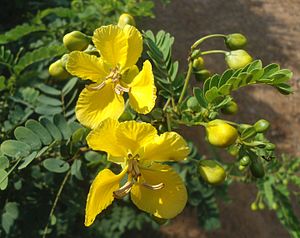Note: This is a project under development. The articles on this wiki are just being initiated and broadly incomplete. You can Help creating new pages.
Difference between revisions of "Senna auriculata - Ahulya"
(→How to plant/cultivate) |
(→How to plant/cultivate) |
||
| (One intermediate revision by the same user not shown) | |||
| Line 53: | Line 53: | ||
Seed - it has a hard seedcoat and needs scarification before sowing to speed up germination. This can usually be done by pouring a small amount of nearly boiling water on the seeds (being careful not to cook them!) and then soaking them for 12 - 24 hours in warm water. By this time they should have imbibed moisture and swollen - if they have not, then carefully make a nick in the seedcoat (being careful not to damage the embryo) and soak for a further 12 hours. Cuttings. | Seed - it has a hard seedcoat and needs scarification before sowing to speed up germination. This can usually be done by pouring a small amount of nearly boiling water on the seeds (being careful not to cook them!) and then soaking them for 12 - 24 hours in warm water. By this time they should have imbibed moisture and swollen - if they have not, then carefully make a nick in the seedcoat (being careful not to damage the embryo) and soak for a further 12 hours. Cuttings. | ||
| − | <ref name=Cultivation details"/> | + | <ref name="Cultivation details"/> |
==Commonly seen growing in areas== | ==Commonly seen growing in areas== | ||
| Line 72: | Line 72: | ||
<ref name="Leaf">[http://keralaplants.in/flowering-plants-kerala-dvd.aspx Botonic description]</ref> | <ref name="Leaf">[http://keralaplants.in/flowering-plants-kerala-dvd.aspx Botonic description]</ref> | ||
<ref name="Common names">[http://envis.frlht.org/bot_search Vernacular names]</ref> | <ref name="Common names">[http://envis.frlht.org/bot_search Vernacular names]</ref> | ||
| + | <ref name="Cultivation details">[http://tropical.theferns.info/viewtropical.php?id=Senna+auriculata Cultivation details]</ref> | ||
| + | |||
</references> | </references> | ||
Latest revision as of 10:41, 13 June 2019
Ahulya, is a shrub or small tree growing up to 7 metres tall. The bole can be 20cm in diameter. A multi-purpose plant with a wide range of local uses for food, medicines and to supply a range of commodities. It was at one time a major source of tannins, especially in southern India.
Contents
- 1 Uses
- 2 Parts Used
- 3 Chemical Composition
- 4 Common names
- 5 Properties
- 6 Habit
- 7 Identification
- 8 List of Ayurvedic medicine in which the herb is used
- 9 Where to get the saplings
- 10 Mode of Propagation
- 11 How to plant/cultivate
- 12 Commonly seen growing in areas
- 13 Photo Gallery
- 14 References
- 15 External Links
Uses
Skin diseases, Excessive bleeding, Excessive thirst, Dysentery, Diabetes [1]
Parts Used
Leaves, {{Parts Used|Flowers}, Bark
Chemical Composition
Common names
| Language | Common name |
|---|---|
| Kannada | aavarike, honnaavare, honnaavarike, olle thangadi |
| Hindi | tarvar, anwal |
| Malayalam | avara, avarakka, avaram |
| Tamil | aavarai, avaram |
| Telugu | avaray, merakatangedu, tangedu |
| Marathi | NA |
| Gujarathi | NA |
| Punjabi | NA |
| Kashmiri | NA |
| Sanskrit | adarisimbi, ahula, ahulya, ahulyam, avartaki, charmaranga |
| English |
Properties
Reference: Dravya - Substance, Rasa - Taste, Guna - Qualities, Veerya - Potency, Vipaka - Post-digesion effect, Karma - Pharmacological activity, Prabhava - Therepeutics.
Dravya
Rasa
Guna
Veerya
Vipaka
Karma
Prabhava
Habit
Identification
Leaf
| Kind | Shape | Feature |
|---|---|---|
| Pinnate | alternate | Leaflets to 2 x 1 cm, oblong-obovate or elliptic, shortly acuminate, pubescent, gland opposite the leaflets, stipitate; petiole 1-1.5 cm, stipules 1 cm, lunate, auricled |
Flower
| Type | Size | Color and composition | Stamen | More information |
|---|---|---|---|---|
| Bisexual | axillary and terminal corymbs | Yellow | 10 | Corymbs axillary and terminal; peduncle 2 cm, pubescent; flowers yellow; larger sepals 1.5 x 1 cm, broadly ovate, obtuse, outer smaller; petals 3-3.5 x 2 cm, ovate, orbicular, clawed; stamens 7 fertile and 3 staminodes. |
Fruit
| Type | Size | Mass | Appearance | Seeds | More information |
|---|---|---|---|---|---|
| A Pod | Pod flat, pubescent, mucronate | {{{6}}} |
Other features
List of Ayurvedic medicine in which the herb is used
Where to get the saplings
Mode of Propagation
How to plant/cultivate
Seed - it has a hard seedcoat and needs scarification before sowing to speed up germination. This can usually be done by pouring a small amount of nearly boiling water on the seeds (being careful not to cook them!) and then soaking them for 12 - 24 hours in warm water. By this time they should have imbibed moisture and swollen - if they have not, then carefully make a nick in the seedcoat (being careful not to damage the embryo) and soak for a further 12 hours. Cuttings. [4]
Commonly seen growing in areas
Photo Gallery
References
External Links
- Ayurvedic Herbs known to be helpful to treat Skin diseases
- Ayurvedic Herbs known to be helpful to treat Excessive bleeding
- Ayurvedic Herbs known to be helpful to treat Excessive thirst
- Ayurvedic Herbs known to be helpful to treat Dysentery
- Ayurvedic Herbs known to be helpful to treat Diabetes
- Herbs with Leaves used in medicine
- Herbs with Bark used in medicine
- Herbs with common name in Kannada
- Herbs with common name in Hindi
- Herbs with common name in Malayalam
- Herbs with common name in Tamil
- Herbs with common name in Telugu
- Herbs with common name in Sanskrit
- Habit - Shrub
- Index of Plants which can be propagated by Seeds
- Index of Plants which can be propagated by Cuttings
- Herbs that are commonly seen in the region of Tropical area
- Herbs
- Fabaceae
- Ayurvedic herbs that don't have seed photos




